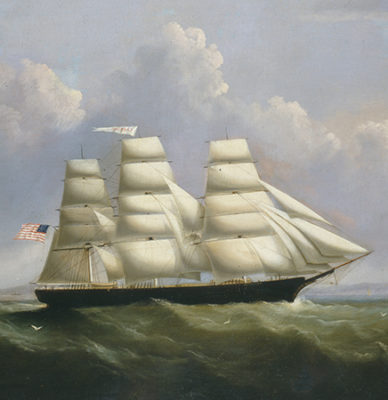Risky Business: Square-Rigged Ships and Salted Fish
View some highlights from our 2019-2020 exhibit with this virtual tour. Click on the right arrow to begin the exhibit. For best viewing, click the  to the right of the page numbers at the bottom of the slideshow to view in full screen, which is best viewed on PCs, Macs and iPads. Please note that full screen mode may be limited on iphones.
to the right of the page numbers at the bottom of the slideshow to view in full screen, which is best viewed on PCs, Macs and iPads. Please note that full screen mode may be limited on iphones.
 With its 2020-2021 special exhibit, the Castine Historical Society invites visitors to step back in time to the 1800s when Castine’s working waterfront thrived on a global market. Shipyards and a dozen active wharves stood along a half mile Castine Harbor. Chandleries and sailmakers on Water and Sea Streets outfitted schooners and square-riggers amidst the smell of tar and fish and wood.
With its 2020-2021 special exhibit, the Castine Historical Society invites visitors to step back in time to the 1800s when Castine’s working waterfront thrived on a global market. Shipyards and a dozen active wharves stood along a half mile Castine Harbor. Chandleries and sailmakers on Water and Sea Streets outfitted schooners and square-riggers amidst the smell of tar and fish and wood.
Castine merchants and shipowners ran an effective and largely self-contained international trade in fish, cotton, and salt from about 1820 to 1860. But not without trouble, hardship, and loss for almost everyone involved. This economic prosperity depended, after all, on men and women sailing wooden ships out into Penobscot Bay and across the open ocean to carry merchandise to distant ports.
The motivation for this exhibit is the extensive research and writings of guest curator Richard Ames whose family history served as a catalyst for his study. The Castine Historical Society has published Ames’ fully-illustrated book, Risky Business: A Maine Village Goes Global, which can be purchased here.

